Every night could be an aurora night. Don't Miss Out
Iceland in spring combines the best of both worlds—longer days and milder temperatures without peak-season crowds. With nature coming alive and the Northern Lights still painting the sky, it’s a fantastic time to experience the country’s charm.
Spring, known as Iceland's ‘shoulder season,’ usually stretches from early March to late May, bringing longer and warmer days. This makes way for outdoor adventures like hiking, sightseeing, and wildlife spotting. With fewer tourists, springtime is one of the cheapest times to visit Iceland. However, Iceland in the spring can feel like a beast with a wild temperament. The ever-changing weather transforms landscapes, creating striking contrasts of snow and emerging greenery. Get ready!
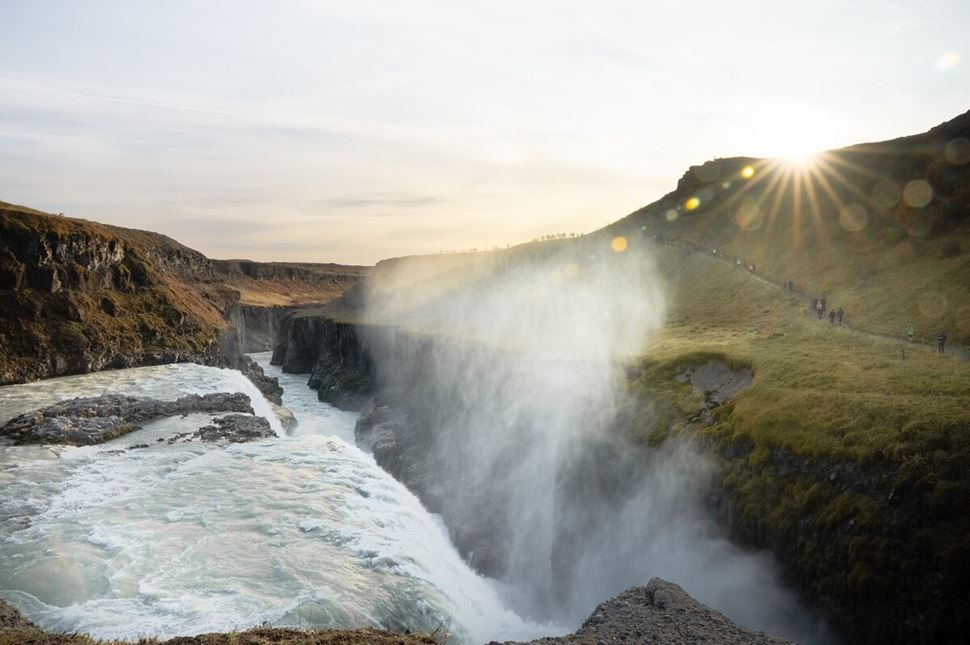
Spring in Iceland: Gullfoss waterfall with melting snow. Source: Bessi Friðþjófsson
The climate in Iceland is characterized by relatively cool summers and mild winters, with sudden weather changes. The beauty of such dynamic and raw nature is best seen in shoulder (transitionary) seasons like spring and autumn. Iceland weather in spring will greet you with everything from sun to snow, sleet, or rain—all in one day—with temperatures ranging from -1 to 10°C (30–50°F). Prepare well and experience the wild!
SEASONS IN ICELAND:
Historically, Icelanders divided the year into two seasons—dark, frosty winters and sun-drenched summers. As times changed and people became less dependent on the weather, Iceland adopted the four-season model used across Europe. Although the old way still influences traditions, springtime in Iceland is now recognized as a proper season, typically running from March to May.
DAYLIGHT HOURS AND SEASONAL CHANGES:
The spring equinox (when day and night equalize) on March 20th or 21st marks a seasonal change, bringing a dramatic increase in daylight. By the end of May, Iceland experiences 20 hours of light, compared to just 4 in December. The days continue to lengthen, leading to the Midnight Sun phenomenon, with nearly 24 hours of daylight.
TEMPERATURE VARIATIONS (MARCH, APRIL, MAY):
Iceland climate in spring keeps you on your toes. The temperatures in March often drop below 0°C (32°F), creating a lingering wintry feel. April in Iceland gets milder, but snow trades places with rain. The weather in May brings a touch of summer, with temperatures climbing up to 10°C (50°F). When exploring the spring season in Iceland, check the forecast daily and pack waterproof, layered clothes to stay warm and dry.
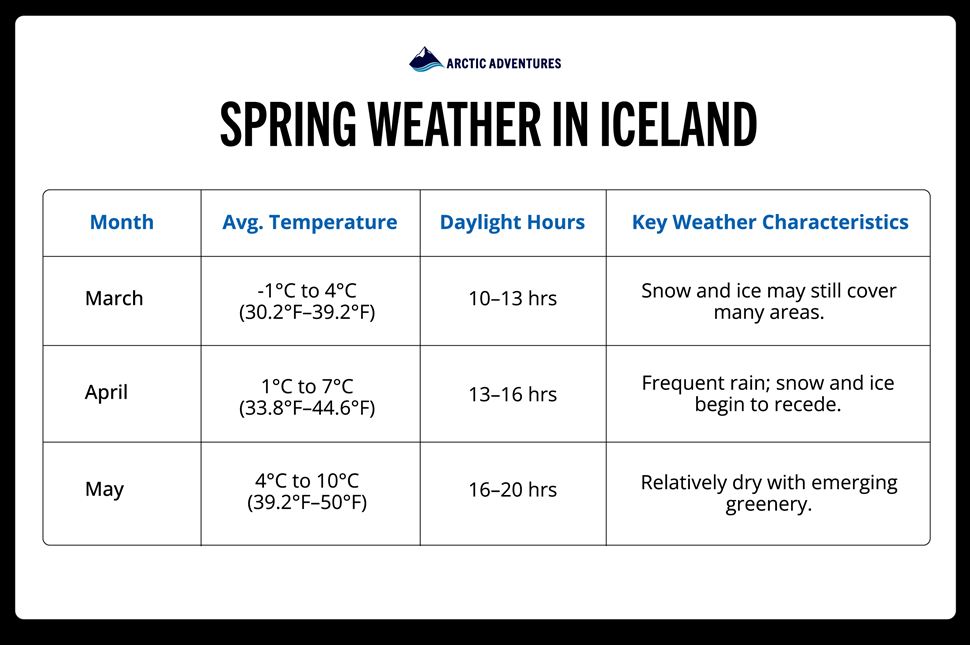
Weather in Iceland in spring months: March, April, and May. Source: timeanddate.com
Rain, snow, and road conditions: Springtime road conditions in Iceland can vary depending on the location. While the main Ring Road is well-maintained, remote gravel roads may be hard to pass. Rain, snow, and ice are the main components affecting driving conditions in Iceland in March, April, and May, making the roads slippery. Strong winds change the weather quickly, so inspecting the real-time road conditions is key.
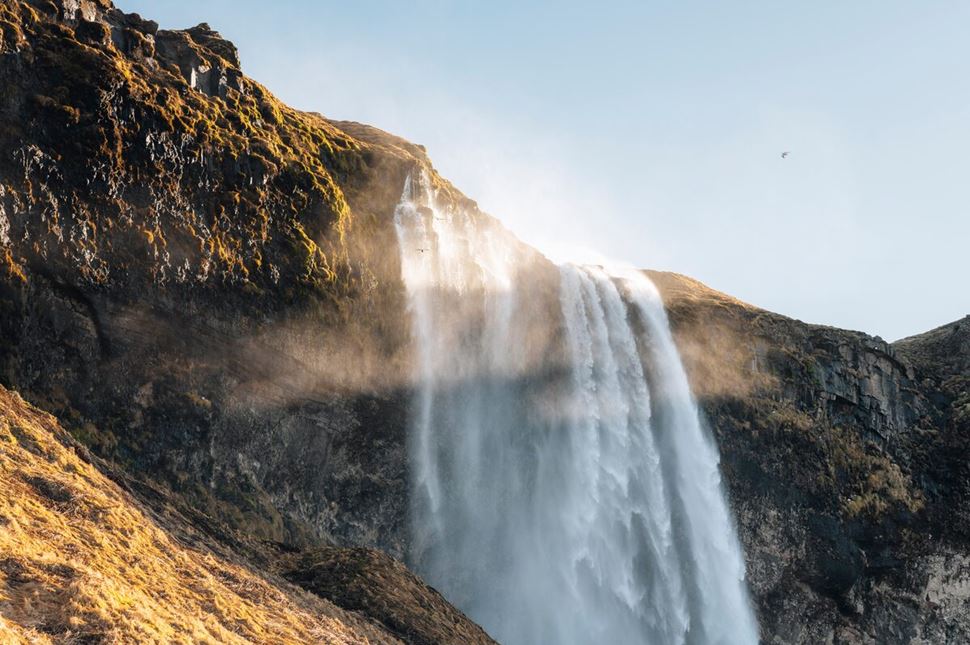
Dramatic and powerful Skógafoss waterfall. Photo by Gunnar Gaukur.
The Icelandic spring season reveals not only the beauty of awakening nature but also exciting activities, from sightseeing and wildlife watching to hiking and hot potting. Explore waterfalls roaring like tigers, glaciers shimmering under the sun, and warm, steamy pools inviting you to relax. With spring being the off-season, it’s one of the cheapest times to visit—perfect for an Iceland spring break that won’t break the bank.
Exploring waterfalls (Seljalandsfoss, Skogafoss, Gullfoss):
Icelandic waterfalls are at their best during springtime. As the ice melts, the water flows stronger and faster, making the falls more powerful and dramatic. With long daylight hours, you can explore top Icelandic cascades in a single day—walk behind Seljalandsfoss, marvel at Skogafoss, or see the iconic Gullfoss. For the sweeping views, visit in the morning or afternoon when the light enhances the mist and creates rainbows.
Glacier hiking and ice caving (Sólheimajökull, Langjökull, Crystal Ice Cave):
If you’re looking for adventurous things to do in Iceland in spring, head to the country’s magnificent glaciers. The spring sun makes them sparkle like a field of diamonds, while the lingering cold keeps it safe to explore the ice caves. Many glacier activities, such as the Sólheimajökull hike or Langjökull Ice Tunnel, are accessible year-round, but some, like the Crystal Ice Cave, are only open until April. Don’t miss your chance to see them!
Hot springs and geothermal pools (Blue Lagoon, Secret Lagoon, Reykjadalur Valley):
While spring in Iceland can be chilly, it's an excellent opportunity to unwind in one of many geothermal springs or spas. If the weather doesn't cooperate during your trip, you can always take a dip in a steaming, mineral-filled pool and embrace Icelandic traditions while staying warm. Rejuvenate in the famous Blue Lagoon, discover a serene Secret Lagoon, or visit a natural thermal river in the Reykjadalur Valley.
Hiking opportunities (Þórsmörk, Reykjanes Peninsula, Glymur):
Spring signals the start of early hiking opportunities. Although hiking in Iceland in March isn't possible on all trails yet, outdoor enthusiasts are already lacing up their boots and preparing for a trek in the wilderness. If you’re among them, begin your early spring adventures with shorter hikes near the capital, such as the volcano trail in Reykjanes. As the days grow longer in April and May, hit trails like Thorsmörk, where vibrant moss and rushing rivers invite you to venture deep into Iceland’s rugged terrains.
Northern Lights viewing (Red, Purple, Green, Yellow):
If you're lucky, you might still see a spectacular show of the Northern Lights in spring. With the Aurora season lasting from mid-September to April, the early spring months give one last chance to witness this breathtaking phenomenon. While successful sightings in March and April are rarer than in the depths of winter, you can boost your chances by joining the Aurora hunt with expert guides.
Whale watching (Blue whales, Fin whales, Humpback whales):
With one season coming to an end, another just begins. Whale-watching season in Iceland starts in April and lasts until October. Fewer tourists mean a quieter, more intimate experience with Icelandic nature. Some species, like humpbacks and minke whales, tend to be more active during spring as they migrate through Icelandic waters. For the best chances, go for a morning or evening tour and set off from Reykjavík, Dalvík, Ólafsvík, or Akureyri. In the early spring months, you might even combine your whale-watching excursion with a Northern Lights hunt.
Iceland in springtime is ideal for self-drive excursions. Car rental prices are significantly lower than in the summer, especially in April. Road conditions improve compared to winter, and the extended daylight allows for a longer drive. However, occasional snowfall and strong winds make driving more challenging, so stick to main routes like Ring Road 1, which are well-marked and regularly maintained.
The Golden Circle is Iceland’s most popular scenic route, but it can get crowded during peak season. Driving the Golden Circle in spring lets you enjoy its top attractions without a horde of fellow explorers and witness nature’s awakening at each stop. See Thingvellir National Park blooming with fresh greenery, Gullfoss waterfall acquiring a mightier flow, and the hidden Kerid Crater revealing its stunning blue lake.
Spring is perfect for exploring the South Coast of Iceland, home to spectacular waterfalls, black sand beaches, and charming coastal towns. Some attractions are busy in summer and hard to access in winter, making the off-season the best of both worlds. Witness the basalt columns at Reynisfjara beach, the ice-speckled Diamond Beach, and the picturesque fishing village of Vík as it awakens with fresh greenery.
A road trip to Snæfellsnes in spring unveils incredible natural wonders at their finest—moss-covered lava fields, towering mountains, and waterfalls. Visit the 4000-year-old Berserkjahraun valley as it begins to show its contrasting colors of black lava and green vegetation. Listen to the breathtaking Barnafoss waterfall whisper its legends and stand next to a steep Mt. Kirkjufell bathed in the spring sun.
The Westfjords of Iceland are a true quiet escape with exceptional hiking trails and abundant wildlife. In Hornstrandir, Arctic foxes roam freely, often spotted along the trails. Charming fishing towns breathe history, while hidden waterfalls like Dynjandi provide stunning photo spots. Heavy snowfall often makes this remote region inaccessible from October to March. The best time to visit Westfjords starts in April, when the flowers start to bloom, making the place look like a fairytale.
If you love discovering precious gems, add the Silver Circle to your bucket list. Less known than the Golden Circle, it’s a great alternative—quiet but rich in wonders. Spring is a lovely time to visit this iconic round-trip path. The tiny streams of Hraunfossar falls trickle over a lava field, Husafell forests thrive, and the warm Krauma Wellness Center invites you for a geothermal spa experience.
After a long and dark winter, Icelanders eagerly welcome the arrival of spring with joy and excitement. In addition to global celebrations like Easter, the country hosts unique and traditional festivities that can enrich your spring break in Iceland:
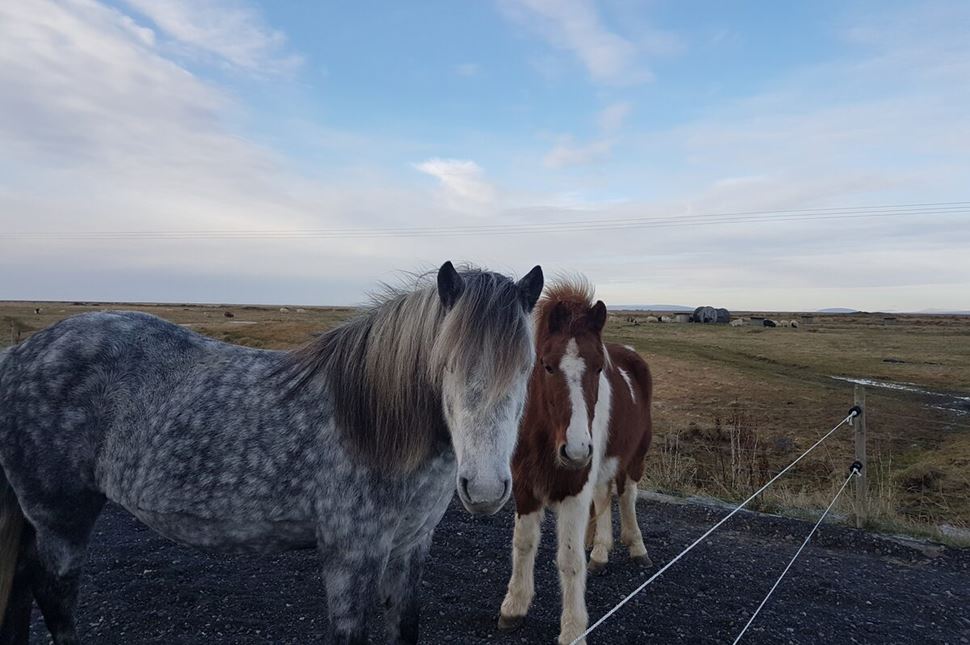
Icelandic horses enjoying spring weather. Source: Arctic Adventures.
Spring is a grand renewal of Icelandic nature. The country sheds its wintry skin like a snake, revealing vibrant hues. Even animals, like arctic foxes, change their fur from white to brown to blend into the new landscape.
ICELANDIC FLORA AND LANDSCAPES:
If you want to see a country transform before your eyes, go to Iceland in springtime. As winter loosens its grip, nature begins to show its true colors. Black lava fields dress in a green fur coat of moss, birch forests shake off their snow, and wildflowers begin to dot the fields. You start to notice far more details in Iceland’s landscape—steam vents glow yellow from sulfur, while rhyolite mountains blend striking shades of red, pink, orange, and blue. This transformation unfolds alongside the last occasional winter snow, a gentle reminder of the passing white season.
WILDLIFE SPOTTING:
One of the most anticipated signs of spring is the return of the golden plover, usually during the last week of March. Icelanders consider it the faithful messenger of the warm season. Another beloved spring visitor is the puffin. These adorable, comical birds return to seaside cliffs to breed, making it the perfect time to spot entire colonies of their bright-beaked charm.
Beyond birds, you can spot a variety of wild animals. Fluffy-tailed arctic foxes, Icelandic horses, whales, reindeer, sheep, and seals become more active in springtime. Many tours during this season focus specifically on wildlife watching.
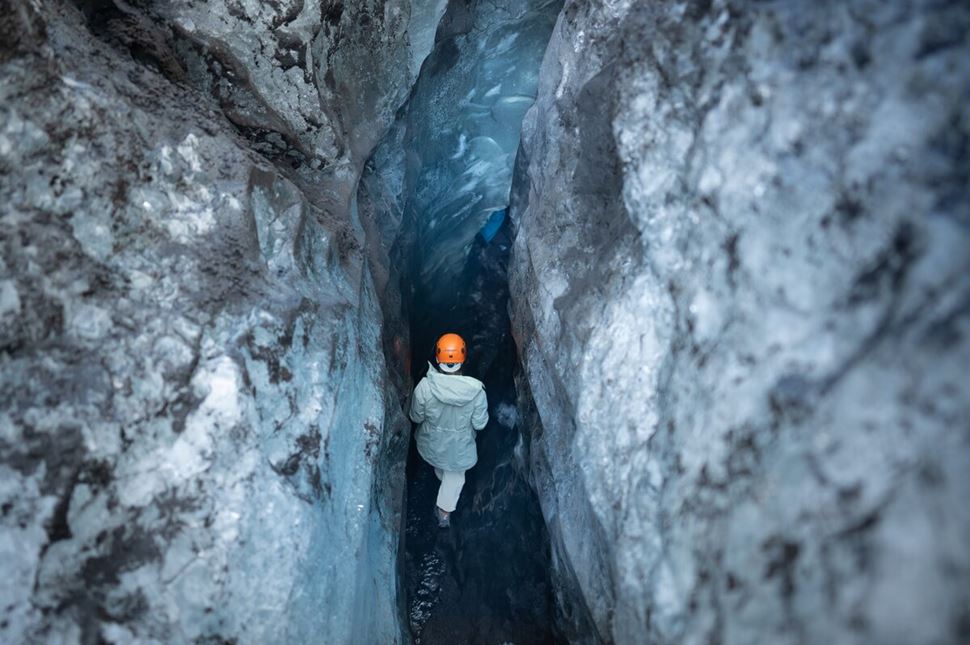
Explorer entering the Crystal Ice Cave in spring. Photo provided by Bessi Friðþjófsson.
Even though spring is a single season, each month has its own distinct character. The weather in Iceland in March feels worlds apart from Iceland in early May, while April blends elements of both.
While spring’s awakening makes it one of the most beautiful times to experience the country, visiting Iceland in the spring has pros and cons. Take note of what to expect and make the most of your trip with some spring travel tips!
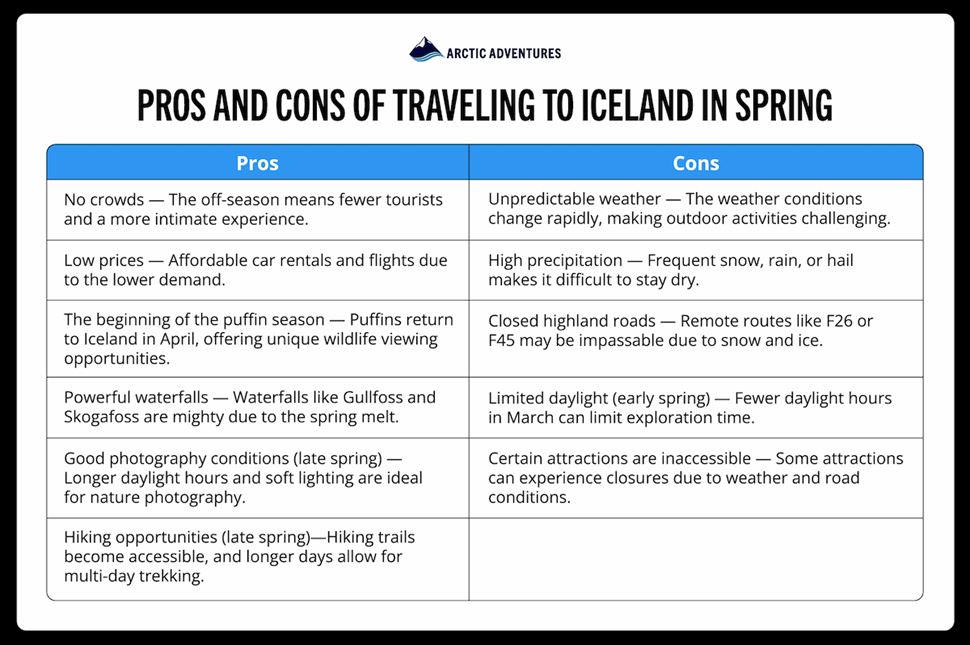
Pros and cons of visiting Iceland in spring. Arctic Adventures.
There’s no bad weather, only extreme opportunities for layering and a chance to discover how stylish rain gear can be. If you focus on what to pack for Iceland in spring, the weather will become your friend, not your enemy.
Yes, Iceland experiences seasonal changes every year. The most noticeable weather differences are between summer and winter, but both spring and autumn are distinct seasons. Spring in Iceland is marked by rapid weather changes, summer is mild with long daylight hours, autumn brings vibrant colors, while winter is white and frosty.
Spring is a fantastic time to visit Iceland. Nature comes to life, unveiling the vibrant colors of lava fields, rhyolite mountains, and hot spring areas. However, the unpredictable weather during the shoulder season presents some difficulties when choosing apparel. But with careful packing and easy-to-layer clothes, these challenges can be easily overcome.
No, Iceland is not crowded in spring because it’s the off-season. Most tourists arrive between June and August, so the country feels quiet and peaceful in spring. With fewer crowds, you can explore popular attractions like the Golden Circle and enjoy a more intimate experience with Icelandic nature.
While March in Iceland is better for enjoying winter activities like Northern Lights chasing, April is perfect for summery adventures like wildlife watching. The choice depends on what you wish to experience—explore ice caves in March or try adventurous hiking in Iceland in April.
It is possible to see the Northern Lights in April, but the chances are lower than in late winter and early spring months like February and March. If you want to see the Auroras, rely on professional equipment and expert guides who can track the Northern Lights activity.
Seeing the Northern Lights in May is rare but still possible. The highest chance to see the Aurora is at midnight. Our Northern Lights hunting tours run until late May and offer free retries valid for up to 3 years if the lights don’t appear.
Yes, you can hike in Iceland during spring. While some remote trails may still be closed due to snow and ice, paths near Reykjavík are ideal for shorter early-season hikes. As the days grow longer and warmer, multi-day treks like Landmannalaugar become more accessible.
While spring weather in Iceland can still feel wintery, April is not too cold. Temperatures rarely drop below 1°C (33.8°F) and often reach up to 7°C (44.6°F). Dressing in layers and avoiding moisture-absorbing fabrics like cotton will help you stay warm and comfortable.
Compared with earlier spring months, May in Iceland is not that cold, hinting at summer weather. Nights can be chilly, with temperatures dropping to 4°C (39.2°F), while daytime highs can reach up to 10°C (50°F). If you’re heading to Iceland in May, remember to pack a pair of warm wool socks and a winter hat.
Driving in Iceland in April is safe if you stick to the main roads like Ring Road. Those are regularly maintained and rarely experience closures due to snow. Driving on rugged gravel roads in April is more challenging and requires experience with icy conditions. If you are unsure about driving in Iceland, you can join guided bus tours, where professional drivers handle all the transportation.
Most road signs in Iceland are in Icelandic, but they typically use universal symbols that are easy to understand, providing clear information, warnings, and guidance. They are well-placed along highways, roadsides, and intersections, ensuring drivers’ visibility.
You can see puffins in Iceland in spring gathering on rocky cliffsides along the ocean. If you want to witness the largest colony of puffins in the country, go to the Westman Islands, 114 km (71 mi) from Reykjavik. Another favorite spot of these charming birds is Borgarfjörður Eystri in the northeast. Approximately 10,000 pairs of puffins nest there each year.